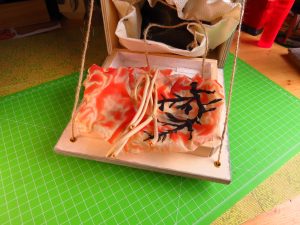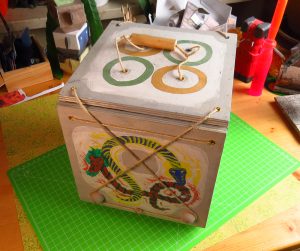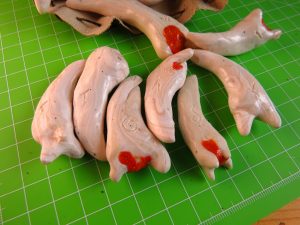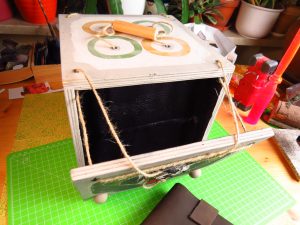This is probably one of the least used props that I have ever made. The character I made it for never really got played as a player character and quickly turned into an NPC to accompany my group and allow me to throw in the odd mean comment. Her ritual chest saw use in the game, but the prop version had been collecting dust for a while now. So I thought I would share it with you, hoping that it may inspire you.
Who is Despaira?
Despaira, while not vital to this prop, was a red-skinned, black-haired tiefling female. She was a star pact warlock, at least she was when we played 4e. I have not updated her to 5e yet. She was a fortune teller by trade, based on what her mother and her grandmother had taught her. She was also a thief and con-artist, again, based on her lineage.
She excelled in the art of seduction and deception, usually at the same time. The only other prop she ever got was a necklace with a couple of teeth that I found at a medieval fair, which she used to refer to when she swore. Her catchphrase was “by the teeth of my grandmother”. Strangely enough, her grandmothers are both still alive, or so she claims.
So you think there is a bad pun to be made with a seductive female tiefling and her chest? Possibly, but I got that covered as well – in this Instructable about how I made her “chest” from felt. Don’t judge me (why would you?). Sadly, I never got around to finishing her tail or her horns since I did not get to play her that much anymore. But there you are.
Why did Despaira need a Ritual Chest?
On top of being a Warlock, a class that could easily be flavored using physical rituals, Despaira was not your ordinary PC. She was (and is) mine, and since I am the campaign’s dungeon master, I did not think I could play her to the best of her abilities with a full character sheet. Instead, I came up with an idea to achieve the following. Make her a valuable member of the party, and offset the lack of a fourth player.
I should add that this was during 3.5/4e, and for some reason that I do not recall there was some need to balance for four players. Maybe I was just inexperienced, though. In addition, I did not want her to take up too much of my time because, at that time, we were rather slow when it came to combat encounters.
The Inspiration to make this an actual ritual chest instead of just just a flavor ritual actually came from the song Dark Chest of Wonders by Nightwish. “Open the chest once more…”
My solution was to have her conduct rituals, tucked away somewhere on the battlefield (where, miraculously, nobody would attack her). What she would do is to use her ritual chest to unfold a “ritual proboscis” and probe the cosmos for aide. The idea was that this proboscis would then make contact with another plane or entity, and an effect would occur based on a percentile die.
The corresponding table was designed to encompass results from good to bad, leaning somewhat toward the good side, but I will go into that in another post, another time.
General Construction of the Ritual Chest
I made this box from plywood with a thickness of about 3/8″ thickness. The basic design is a box without bottom and top, or a square tube if you will. To this, I added two doors, attached with piano hinges, one with a square frame added to make it into a tray. You can see all that in the pictures further below.
Here you can see the screws I used to connect the pieces. There are probably easier joinery methods to use, especially if you have a proper wood shop on hand. Back when I made the ritual chest I did not. Instead, I made this in our boiler room with a single workbench, a table saw and a drill. The only difference would be the time spent on making the chest. It is plenty sturdy for what it needs to do. Which, mechanically speaking, is not very much. From this angle, you can also see the “riser” I made from store-bought molding on the bottom to keep it “afloat”.
To carry the ritual chest, I drilled four holes into the top and set small cloth-rivets into them for a cleaner look. Through those, I threaded a piece of cord, which I ran through a wooden dowel. You can probably tell that the center hole has been drilled in what you might call a haphazard fashion. But it does the job, and Despaira would probably be able to sell it as a feature. The weight balance of the handle is much better that way. Also, the string is a single piece with a knot on the inside.
Speaking of inside, I added a cloth bag to each side to turn the open “tube” into a proper ritual chest. I sewed them from a sturdy fabric that, as far as I recall, came from an old curtain – or was meant to become one. You can see more of that below when I show you the light side of the ritual chest.
Artwork on the Ritual Chest
The idea behind the ritual chest was to make it a family heirloom for Despaira. This way, she could have what could amount to a powerful magical item without actually earning it herself, while it still retained some of its magic simply because she did not know how to use it. As such, I wanted to paint it in a decorative fashion, thinking that there has been enough time in this item’s existence for someone to want to make it pretty.
This is the “light side”, the flap that Despaira opens to conduct her rituals. The creatures depicted are inspired by the Couatls of the 4th edition of Dungeons & Dragons. At least in my mind, they worked as generally “good” creatures, akin to dragons bringing luck in some Asian cultures. Looking back it would have been cool to have a hidden meaning in their pattern or their positioning, but I did not think of that at the time.
For the sides, I wanted to incorporate overarching themes from the campaign (which, by the way, is still running six years later). On this one, I combined the symbols of the three gods that would play an important role in the events to unfold. There is the eye of Ioun in the center, sticking out of the swirl of the Nameless One, surrounded by the sun symbol of Pelor. The later is a little subtle with the six tiny “spikes”, but I did not want to be too direct here. More like “Hey, look, this has always been there!” after the fact, instead of giving anything away. Then again, the involvement of these three entities does not give away much of the story anyway.

On the other side, I tried my hand at depicting the Living Gate. At that point, I already had the idea to use it as one of the milestones of the campaign, but the design I eventually used looked different than what I drew here. Looking back, the design on the box would have been the more interesting, with the gate (presumably) laying flat and the doors being two slabs that pivot out of the way. In retrospect, I cannot help but think that some googly eyes would have made the far realms far more disconcerting.
I mentioned before that there was a light side on the chest, the one which Despaira uses frequently. This is the Dark Side of her Ritual Chest. If the snakehead with its bog fangs is not enough to convince you, maybe the seal is. I go into the locking mechanism as well as how to cheat this seal below, but suffice to say that this has never been opened. That is to say, when I learned how to push the characters to the point where there was an actual risk in the battle, we had stopped using the chest as much. Which is sad, in a way.
The Locking Mechanism
As you can see in the pictures of both the light and the dark side, the “lock” for these is string-based and doubles as a way to hold the sides in position when opened. If there is any interest let me know and I will make a video demonstrating how it works.
In effect, I took a piece of string and drilled four holes, two through the top and two through the lid. Now I threaded the string through those four holes, staying on the outside between holes on the same piece and on the inside for those connections between parts. I hope that makes sense, but, but the pictures should clarify it a bit.
Now, to close the chest you take the string on the top, thus pulling the lid up and eventually shut. To keep it from flopping down once you release the string I wanted some simple method of holding it in place. First, I pulled it down over the lid and discovered that if I twist it once, not only would it look nice, but the potential hold-points came pretty much down to the corners.
I used bought wooden half-sphered. I filed them down on one side to get kind of a ledge, and placed them on the lid so that you can push the string over them and it will be taut. The aforementioned ledge is small enough so that you can easily slip the string out when you want to open the box.
The Light side of the Ritual Chest
This side opens up to the majority of the box, as signified by a cloth bag glued to the walls of the construct. It comes with a drawstring to close the bag and add another layer of protection for those precious oracles inside it.
I will go into the actual oracles below, but admittedly, they never got used in the game. I think they would work well to play out a ritual outside of combat, but sadly, we never had one of those. And during combat, time is too prescious, and rolling on that table works just fine.
The flap folds down to turn into a tray, held in place by the two strings. The tray itself is inspired by the concept ritual trays (name may vary) that I found on Pinterest. The idea, as far as I could tell, was to determine the outcome by where something thrown down on them came to rest.
I chose animals based on background lore in the campaign that never really came into play. At one point I considered adding more as the campaign progressed, but while I still think that would have been cool had the chest seen a little more use, it never came to that.
The Oracles

The idea behind the ritual chest is that is has been handed down through the generations in Despaira’s family. As such, I would expect it to contain what people could get their hands on and what turned out to work alright – either as oracle or as device to deceive gullible folk.
The first entry is a simple one, and very open for interpretation. I grabbed a bunch of dried-up orchid flower stems and rolled them up in a piece of “skin”. That skin is actually latex leftovers poured on baking paper, and it happened to turn out red and white-ish. To set it apart, I did add some black veins to it.
Another oracle came rather easy in the shape of three dice that you can print out and build. I could not find the link for them – I did not design them myself – and admitedly, they are the most “boring” ones to use when actually roleplaying a ritual. But they are a solid foundation, and can be tied to a number of stories. also, they do not get in the way much seeing how they fit in the very back corner of the box.
And then there is my “finest” oracle. At least the one that I put most work into. It is the famed Oracle of Dragon Teeth, and as such the precursor to WPC’s first proper paper product (which you can find here!).
I made these from modelling clay. I cannot recall the color, but I believe it was a mix of white and some kind of stone-like version, complete with a slight glitter effect. These teeth are not as diverse as those from the paper set, and I never got round to making some intricate enough to match the flat designs.
When I made these I wanted to add some kind of secret meaning to them, and I scratched symbold into almost every tooth. A must-include at the time was the spiral, the symbol of the Nameless one that would play a big role towards the end of the campaign – literelly years later. I imagined that I could use it to great effect with a bit of slight of hand, but for that, the markings were too subtle and the orace never got used that way anyway.
The Dark Side of Despaira’s Chest
Since I mentioned there being a light side that contains a number of rituals and takes up most of the interior, you are probably not surprised that there is a dark side to Despaira’s ritual chest as well. I mean, I told you there was further up. The idea behind this is that during their time as soothsayers and, more often than not, frauds, the women in Despaira’s family encountered evil from time to time. And some of it, they took in order to protect the world and, likely to have on hand should the situation requires it. They were a practical bunch, after all.
Hence, the dark side of the chest is adorned with a menacing snake head with huge fangs. In addition to that, it comes complete with a magically charged and impenetrable seal, put there to prevent the opening of said dark side. Well, it is not impenetrable, but only Despaira herself, and all of her female blood relatives, can gain access to it. What happens when the seal is broken? Maybe nothing. Maybe some untold horror is unleashed. It is probably best that during the short run of this as an actual prop, things never were dire enough for the party to find out.
Cheating the Dark Side
The idea of sealing one side shut to protect the cosmos is all fine and dandy, but from the perspective of both a maker and a storyteller, it would be untoward to seal something that you might need to access later. Maybe you want to leave a clue in there that you did not conceive before. Or you need to make some repairs that are not possible from the other side.

This is the point where I would like to praise my ingeniuity and engineering prowess in creating this workaround. As a matter of fact, I was surprised by this, even though I should have seen it coming. I created the locking mechanism similar to the one on the light side, then added the seal made from pieces of plywood and some actual sealing wax. As far as life lessons go, if you want to seal unspeakable evil in, make sure to get some wax on the strings, too.
Because with out that key feature, you can easily slip the string off of the half-spheres and thread it through the seal to open the flap at least half-way – enough to get to anything inside, and to do whatever needs doing in there.
At the moment, the dark side contains only a single item, which is not even a ritual as such. It qualifies as a dangerous and valuable magical item, and it would be interesting to let the PCs have a crack at it – if they want to.
The Deck of Many Things – What else?
The Deck of Many Things is an iconic D&D artefact that, while not actually evil, can result in anything from awesomness to ruin. The idea is that you draw a card (or more) and receive an effect for it. Among the effects are magic items or henchmen that will follow you, as well as riches in various forms. But there are also less pleasant cards. Some pit you against a foe that instantly begins to plot your demise, while others may permanently damage your character in terms of stat loss.
The deck that I used came from the 177th issue of Dungeon Magazine, from an article by Rodney Thompson. You can find that issue along with the cards to print here. What I did make is the leather pouch, complete with some clasp hardware and a ying-yang symbol mirroring the back of this particular deck. There are other decks, all using the same cards detailed in the original item description, and you can even use a standard deck of cards to portray it in game.
In-Game-Use of the Ritual Chest
Like I said, the chest itself has seen little use during our games, mainly because I was busy being the dungeon master and did not want to take the time to play out spells cast as ritual effects the way I might have as a player. As I already stated, we also thought we needed her to balance the party against monsters tweaked against a four-player-group.
In a future article, I will go into the ritual and the table we used, as well as some thoughts about how to improve it. Until then, why don’t you check out my other roleplaying inspiration, or my paper craft?
Subscribe to my newsletter if you enjoy what you find, and as always, remember to Be Inspired!
















